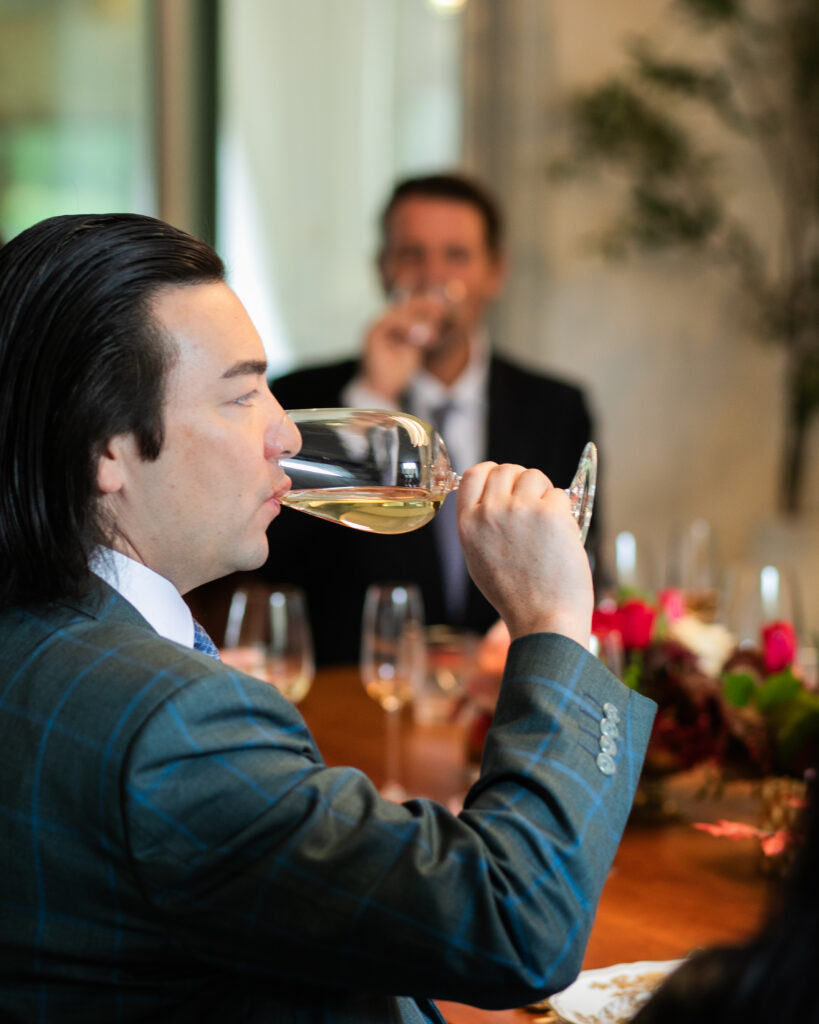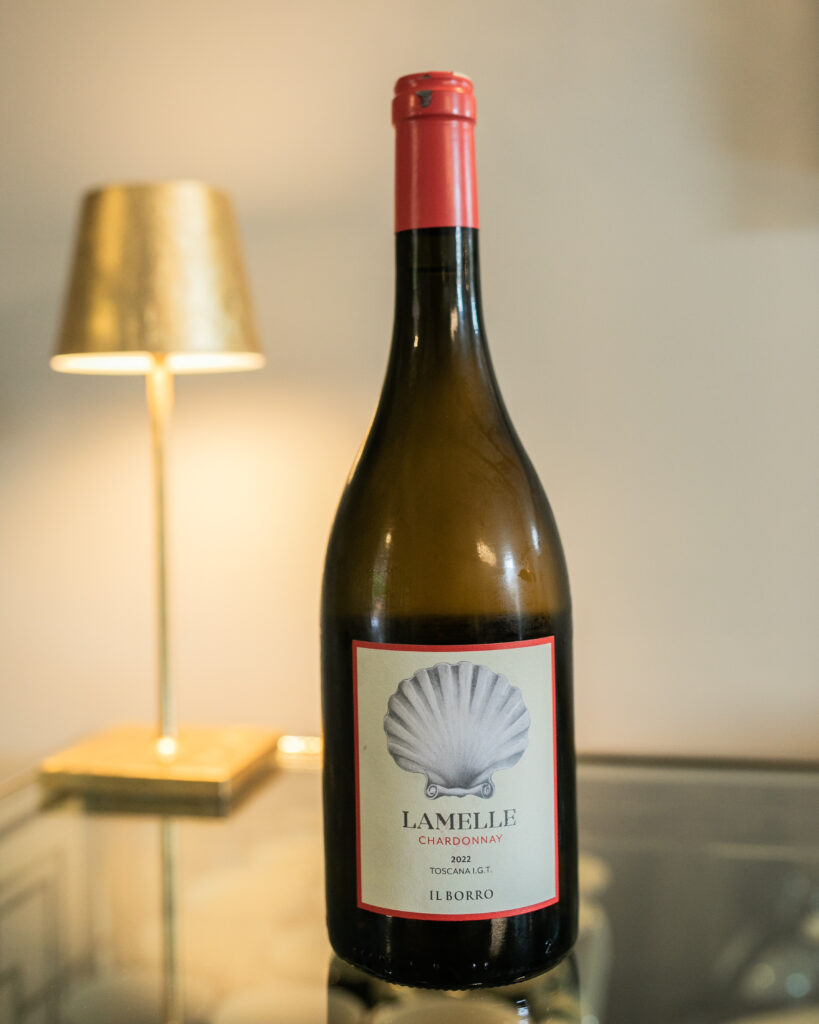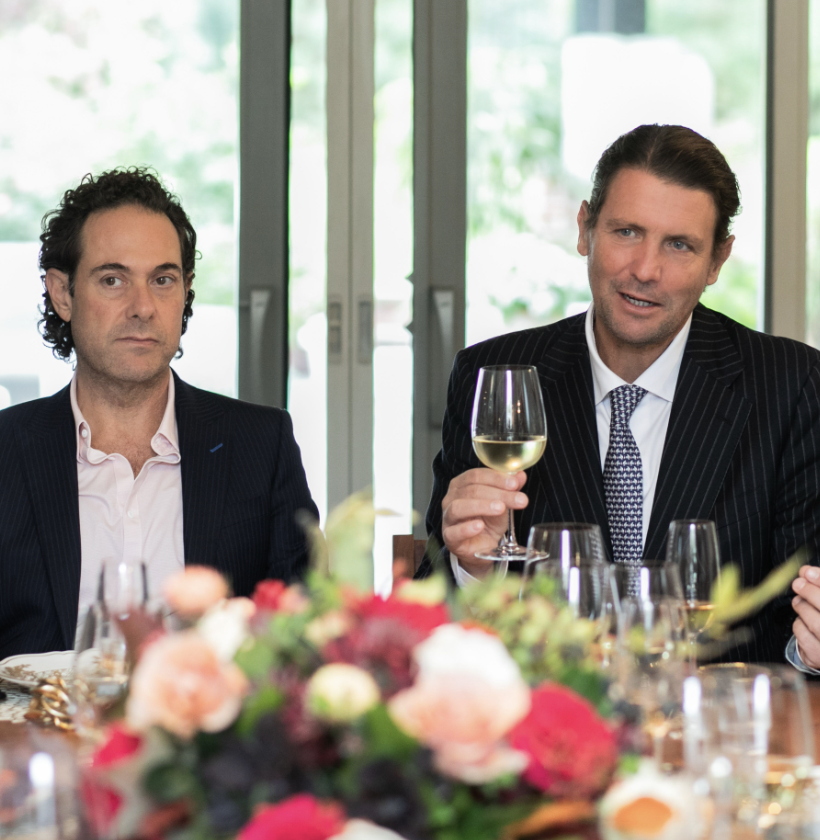As many good gatherings do, this one begins with a story. While visiting Italy in search of phenomenal wines for his business, Medici Importers Global, to bring to the United States, Jason Grant went to Il Borro for dinner. Owned by the Ferragamo family since 1993, this estate and vineyard sits on over 2,700 acres outside of Arezzo. The medieval town at the heart of it, dating at least as far back as 1254, has been made into a resort—a place to stay, to dine, to take long walks, to relax in a spa atmosphere. And to appreciate wines made biodynamically with grapes grown sustainably on-site.
As Jason made his way to his table, he noticed a gentleman having dinner alone. He recognized Ferruccio Ferragamo, son of the founder of the legendary fashion house, and keeper of the family’s legacy of quality and innovation. Mr. Ferragamo took the brand public in 2011 and continues to oversee not just this respected fashion empire, but also Il Borro. In a “timeless act of faith,” he and his children have labored steadily for 30 years to preserve and improve their corner of Tuscany.

With his instinctual friendliness, Jason said to the hostess that, if at all possible, he would love to meet Mr. Ferragamo. When the dopo cena coffee arrived, Mr. Ferragamo joined Jason, which his children later deemed something of a miracle since their father “talks to no one!” Because miracles breed miracles, a conversation grew into a friendship and a business relationship.
From Tuscany to Pittsburgh
Ten months later, Medici Importers Global, now representing the wines of Il Borro in the US, invited Ferruccio’s son Salvatore, who manages Il Borro’s vineyards, to come to Pittsburgh for a lunch and wine tasting for 10 people, and a splendid wine dinner for 160 people at the historic Duquesne Club. Salvatore’s easy charm and his descriptions of each wine enriched the experiences greatly.

TABLE worked closely with Jason on both the lunch and the dinner … each of which began with Bolle di Borro, a sparkling rosé made with a 60-month fermentation on the lees of Sangiovese grapes. A staple of Tuscan winemaking for centuries, Sangiovese gifts Bolle di Borro with the complexities of a red wine. An intriguing breadiness in its aroma yields to a gentle sensation of red berries and hints of candied citrus peel. This symphony of flavor is enlivened by persistent bubbles and grounded with a firm body. As Salvatore explained, it is made with the méthode champenoise, and only a few hundred bottles of it are released. It was a pleasure to mingle, glass in hand, with hosts and guests, as we nibbled foie gras and other appetizing canapés prepared by Hyeholde’s chef and owner, Chris O’Brien.

The Dinnerware
Ginori 1735’s world-famous pattern, Oriente Italiano, has a long history. Its roots are found in Garofano, a pattern said to have kicked off Europe’s passion for porcelain when Marco Polo brought it back from China in 1279. Depicting a vase of carnations on an altar table, it was reproduced for centuries in Faenza (near Bologna) and later in Deruta (near Perugia), both centers of traditional Italian ceramics. It’s still being made by artisans in these locations.

In 1946, at the beginning of Italy’s arduous recovery from World War II, 20th-century design legend Gio Ponti simplified and recolored the traditional Garofano pattern. He rendered the pattern in dark blue, and placed it on a solid ground of vivifying, optimistic color: malachite, iris, pink, or lemon. It became an instant classic. Decades later, Alessandro Michele, former Creative Director of Gucci, works with Ginori to expand the assortment into a total of 12 color options, including the latest: Rubrum (ruby) and Aurum (gold).
A Perfect Pairing
Once seated, a delicious fish anchored the first course of our lunch, accompanied by Il Borro’s Toscana Lamelle. This wine is made from Chardonnay grapes, a variety not often grown in Tuscany. Vines are planted in a zone rich with stone and fossilized shells, making the steel barrel-aged Lamelle at once mineral-forward and rich with the Chardonnay grape’s familiar citrus notes. Excellent in combination with food, a characteristic of most Italian wine, the wine settled pleasingly on the palate by the flesh of Chef Chris’s herb-inflected fish.

A main course of Chef O’Brien’s braised boar and foie gras bucatini was served with Il Borro’s Petruna in Anfora. The making of this wine adapts, at Ferruccio Ferragamo’s request, an ancient Etruscan technique of fermenting grapes in terra cotta amphorae which were sealed and then buried to maintain an even temperature during aging. Housed in climate-controlled buildings, there’s no burying now, but terra cotta vessels still mellow the acidity of Sangiovese grapes and impart an earthy nuance to its red fruit flavors. A hint of green pepper added delicious depth to each sip.

Tradition in a Bottle
The complexity of the flavors of Il Borro’s wines reflect the outlook of the family shepherding the ancient property into modern times. Tradition, embraced in the choice of grapes grown in the fields, and in the techniques deployed in the making of the wine, is augmented by a worldly acquaintance with wines on a global basis. Sparkling rosé and Chardonnay, for example, are not Tuscan staples, yet guided by the palates and preferences of its owners, Il Borro creates a fine space for them within the region’s spectrum of wine.

Something similar is at work in the agriculture and physical plant of Il Borro, as well. From 2007 to 2012, the estate embraced a regenerative return to ancient practices like recapturing rainwater in fall and winter to irrigate the grapes during the hot, dry season. Pruning of the grapes happens only during a waning moon so as not to overtax their natural vascular action. Vines, gardens, and olive groves are fertilized with manure packed into cow horns and composted underground during the cold months. Once unburied in spring, the mica-enriched manure is mixed with water and sprayed into the
fields. Integrated pest management techniques are deployed rather than insecticides.
Recently, horse-drawn carts move through the fields rather than trucks: the exhaust of engines does little for the grapes and their eventual flavor qualities, and the emissions do even less for the planet. In fact, through use of renewable energy systems, Il Borro in its entirety—resort, farm, vineyards, and operations—has achieved a self-sufficient, zero-carbon-emissions status.

Continued Change for the Future
An embrace of change—an optimistic willingness to adapt with the times—without sacrificing the best of the past, is a hallmark of the best fashion houses. It’s certainly part of what has made Ferragamo a force in fashion. It is part of what enchanted us about Il Borro’s wines. We are looking forward to another visit from Salvatore, and further immersion in the wines of Il Borro.

We also look forward to learning more about Italian wine from Jason Grant. He comments: “I feel honored and privileged to be partnered with historic and storied estate vineyards, not only in Tuscany, but all over Italy. I am but one guardian in a long line, preserving the gastronomic heritage and traditions of not only a country but also its people.” He says to stay tuned for more vintner visits to Pittsburgh, and more tasting sessions.
Story by Keith Recker / Photography by Laura Petrilla / Wines by Il Borro and Medici Importers Global / Food by Chef Chris O’Brien, Hyeholde / Table Settings by Glassworks / Dinnerware by Ginori 1735 / Napkins and Rings by Kim Seybert / Placemats by Chilewich / Flowers by Fox and the Fleur / Location courtesy of Stanley and Nikol Marks
Subscribe to TABLE Magazine‘s print edition.

